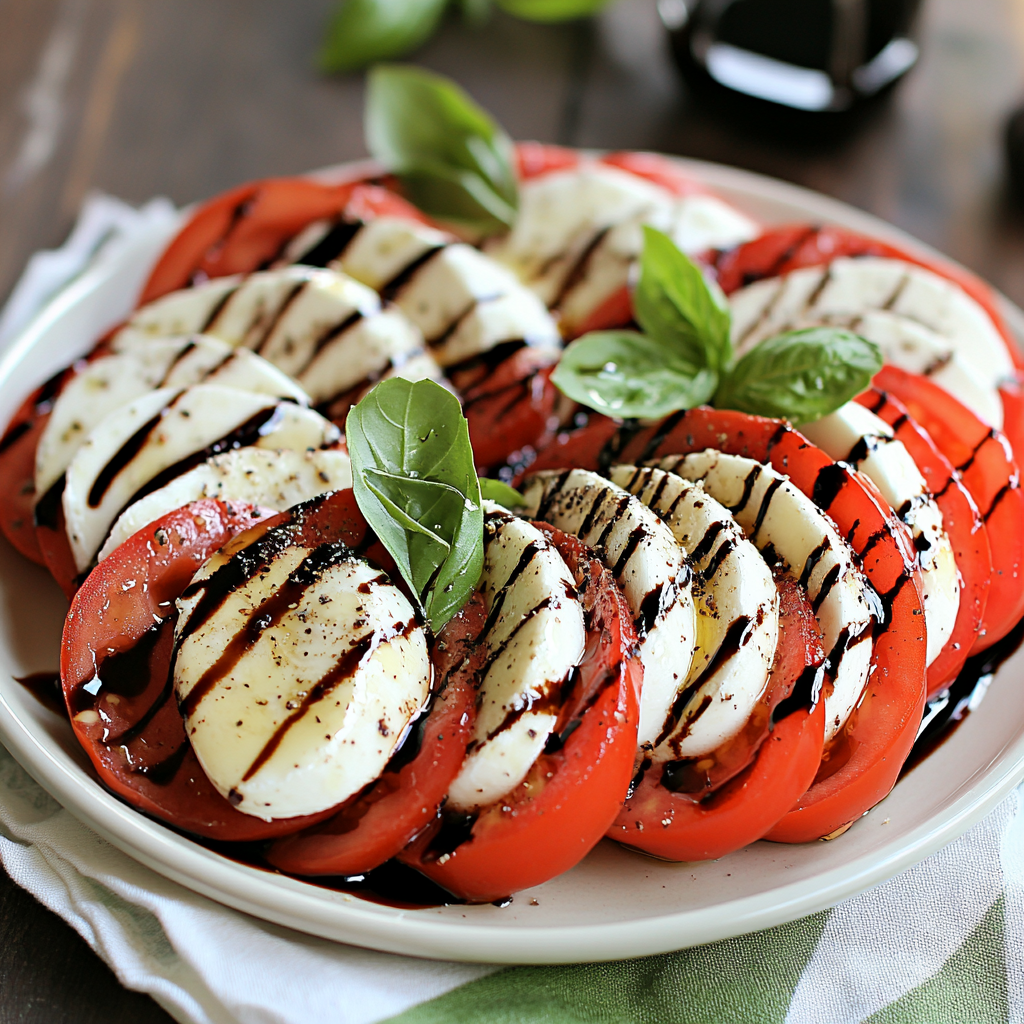Introduction
Overview of Caprese Salad
Caprese salad, a quintessential Italian dish, originates from the island of Capri in Italy. It’s a celebration of simplicity, focusing on fresh, high-quality ingredients: ripe tomatoes, creamy mozzarella, and aromatic basil. This vibrant combination reflects the colors of the Italian flag, symbolizing its national pride. Known for its light and refreshing taste, Caprese salad is commonly enjoyed as an appetizer or side dish. Its popularity has spread globally due to its refreshing flavor and versatility.
The magic of Caprese lies in the quality of its ingredients. Tomatoes, often heirloom or vine-ripened, provide a juicy, slightly tangy base. Fresh mozzarella offers a creamy, soft texture that contrasts beautifully with the tomatoes’ firm bite. Basil adds an herbal freshness, rounding out the dish’s natural flavors. These three ingredients create a harmonious balance that defines the salad.
Role of Balsamic Drizzle
Balsamic drizzle is the perfect finishing touch for Caprese salad. Its rich, tangy-sweet flavor enhances the dish, bringing depth to the otherwise fresh ingredients. The slight acidity of the balsamic vinegar cuts through the creaminess of the mozzarella and complements the sweetness of the tomatoes. The drizzle adds an elegant, glossy sheen, making the salad visually appealing while accentuating its vibrant flavors.
Ingredients
Fresh Ingredients
Tomatoes
The heart of any Caprese salad is the tomato, and choosing the right variety can elevate the dish significantly. Heirloom tomatoes are often the go-to for their rich, sweet flavor and variety of colors, adding a beautiful contrast to the mozzarella and basil. Beefsteak tomatoes are another solid option, offering a dense texture and a deep, savory taste. Vine-ripened tomatoes also perform well, providing a balance of sweetness and acidity that is ideal for this dish. No matter which type you choose, ensure the tomatoes are fully ripe to get the best flavor and juiciness, making them the perfect base for your salad.
Fresh Mozzarella
Mozzarella is the star ingredient in Caprese salad, and using fresh mozzarella makes all the difference. Bocconcini, small balls of mozzarella, are commonly used for their smooth texture and delicate flavor. Alternatively, buffalo mozzarella, made from water buffalo milk, is richer and creamier than its cow’s milk counterpart, offering a luxurious, indulgent texture. The mozzarella should be soft, slightly moist, and have a mild, clean taste that complements the freshness of the tomatoes and the herbaceousness of the basil. Always aim for fresh mozzarella for a truly authentic experience.
Basil
Basil is not only essential for adding fragrance and flavor to Caprese salad, but it also enhances the dish’s aesthetic appeal. The fresh, aromatic leaves of basil provide a peppery, herbal contrast to the creaminess of the mozzarella and the sweetness of the tomatoes. Torn or shredded basil leaves are often used, which intensify the flavor. The vibrant green color of fresh basil brightens the dish, making it visually striking and enhancing the overall presentation.
Olive Oil
To complete the Caprese salad, high-quality olive oil is a must. Extra virgin olive oil is recommended for its fruity, slightly peppery taste, which adds richness to the salad without overpowering the other flavors. The olive oil helps blend the fresh ingredients, creating a harmonious texture and allowing the natural flavors to shine through. The oil’s smooth consistency also contributes to the visual appeal, creating a glossy finish that enhances the overall presentation.
Balsamic Drizzle
Types of Balsamic Vinegar
The balsamic vinegar used for the drizzle should be rich, sweet, and complex. Traditional aged balsamic vinegar from Modena, Italy, offers a syrupy consistency and a deep, tangy flavor that works perfectly in a reduction. It is a premium choice that provides a smooth, balanced sweetness. However, a high-quality commercial balsamic vinegar can also work well for those on a budget, as long as it’s aged and not overly sharp or acidic.
Sweeteners
To balance the sharpness of balsamic vinegar, adding a sweetener like honey, maple syrup, or sugar is essential. These sweeteners not only cut the acidity but also enhance the vinegar’s natural complexity, giving the drizzle a rich, glossy finish. The addition of sugar or honey helps thicken the vinegar as it reduces, creating a syrup-like glaze that beautifully coats the salad, providing the perfect tangy-sweet contrast to the creamy mozzarella and juicy tomatoes.
Tips for Perfection
Selecting the Best Tomatoes
When selecting tomatoes for your Caprese salad, texture and flavor are essential. Opt for tomatoes that are ripe but not overripe—firm with a slight give when pressed. Heirloom tomatoes, with their variety of colors and rich flavors, are a top choice. They offer a deep, tangy taste that contrasts beautifully with the creamy mozzarella. Beefsteak tomatoes are another great option for their thick flesh and sweet, robust flavor. Vine-ripened tomatoes, while common, also provide the perfect balance of acidity and sweetness, giving your salad a fresh, vibrant taste. Avoid tomatoes that feel too soft, as they can become mushy and watery when cut. Additionally, ensure the skin is smooth and free from cracks to guarantee freshness.
Mozzarella and Substitutions
Fresh mozzarella is essential for the creamy, delicate texture that defines Caprese salad. The cheese should be soft, slightly moist, and have a mild, milky flavor. Bocconcini, small, round balls of mozzarella, are commonly used, but buffalo mozzarella is a luxurious alternative. Made from water buffalo milk, it has a richer, creamier taste than cow’s milk mozzarella. If fresh mozzarella is unavailable, burrata is a fantastic substitute. Burrata’s outer mozzarella shell encases a rich, creamy center, providing a luscious texture that complements the other ingredients perfectly. While burrata adds a decadent touch, it’s not a necessity—fresh mozzarella is still the star of the dish.
Making Ahead
Caprese salad is best enjoyed fresh, but you can prepare certain components in advance to save time. Slice the tomatoes and mozzarella ahead of time, but keep them separate until serving to maintain their textures. The basil should only be added just before serving to prevent wilting. For the balsamic drizzle, you can prepare it ahead of time by simmering the balsamic vinegar with sweeteners and letting it cool. Store the components in separate containers in the fridge to preserve freshness, but be mindful of how long they are kept before serving to prevent the tomatoes from losing their texture or the mozzarella becoming soggy.
Serving Suggestions
Caprese salad is a versatile dish that pairs well with many Italian meals. Serve it alongside a hearty pasta, a warm bowl of risotto, or grilled vegetables for a complete Italian-inspired meal. It also works beautifully as a light lunch or a starter before a larger dinner. If you’re serving it as a main, add some crusty bread or roasted potatoes to round out the meal. To enhance the flavor, pair it with a refreshing glass of sparkling water or a light white wine. The balance of creamy mozzarella, fresh tomatoes, and vibrant basil makes this salad a perfect addition to any table.
Garnishing Ideas
Elevate your Caprese salad with simple yet effective garnishing ideas. A sprinkle of flaky sea salt enhances the flavor of the tomatoes and mozzarella, while a few cracks of fresh black pepper can provide an extra kick. For a rustic touch, add whole basil leaves on top, or drizzle extra virgin olive oil over the salad for a glossy finish. If you’re feeling creative, a drizzle of pesto or a few balsamic pearls can add an extra layer of flavor and make the dish even more visually appealing.
FAQs
What is Caprese Salad?
Caprese salad is a simple, classic Italian dish that celebrates fresh, high-quality ingredients. It traditionally consists of three main components: ripe tomatoes, fresh mozzarella, and basil. The salad is named after the island of Capri, where it is said to have originated, and the ingredients reflect the colors of the Italian flag—red tomatoes, white mozzarella, and green basil. Often, it’s finished with a drizzle of olive oil and balsamic vinegar. The dish is known for its vibrant flavors, combining the sweetness of tomatoes, the creaminess of mozzarella, and the freshness of basil, making it a refreshing appetizer or side dish.
What are the best tomatoes for Caprese Salad?
The best tomatoes for Caprese salad are those that are ripe, flavorful, and slightly sweet. Heirloom tomatoes, with their variety of colors and rich flavors, are a top choice. Their natural sweetness and juiciness make them perfect for the dish. Beefsteak tomatoes also work well due to their dense, meaty texture and balanced flavor. Vine-ripened tomatoes are another excellent option, offering a good balance of acidity and sweetness. The key is to select tomatoes that are fully ripe, but not overripe, as this ensures the freshest, most flavorful base for your salad.
How do you make balsamic reduction at home?
Making balsamic reduction at home is simple and quick. Start by pouring balsamic vinegar into a saucepan and bringing it to a gentle simmer over medium heat. Let it cook for 10–15 minutes, stirring occasionally, until it thickens and reduces by half. If you prefer a sweeter glaze, you can add a small amount of honey or sugar during the reduction process. The result should be a syrupy, tangy-sweet balsamic glaze that can be drizzled over your Caprese salad. Be sure to let it cool before serving to prevent it from being too runny.
What can I substitute for mozzarella in Caprese Salad?
While mozzarella is the traditional choice for Caprese salad, there are several great substitutes if you’re looking for variety or have dietary restrictions. Burrata is a richer, creamier alternative that offers a similar texture and flavor profile. If you’re looking for a non-dairy option, vegan mozzarella made from plant-based ingredients like cashews or almonds can also work. Keep in mind that vegan cheeses may have a different texture and flavor, but they can still complement the tomatoes and basil beautifully.
How long does balsamic reduction last?
Balsamic reduction has a relatively long shelf life when stored properly. After making it, allow it to cool and then transfer it to an airtight container. Stored in the refrigerator, it can last up to one month. If the glaze thickens too much during storage, simply reheat it with a splash of water to restore its syrupy consistency.
Can I make Caprese salad ahead of time?
Caprese salad is best enjoyed fresh, but some components can be prepped in advance. You can slice the tomatoes and mozzarella a few hours ahead of time and store them in the refrigerator. However, it’s best to wait to assemble the salad until just before serving to prevent the basil from wilting and the ingredients from becoming soggy. If making the balsamic drizzle ahead of time, store it in a separate container in the fridge and drizzle it over the salad right before serving for the best results.




